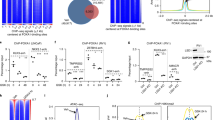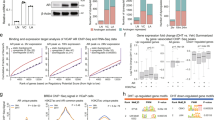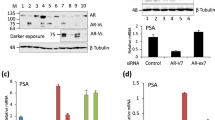Abstract
Hormonal regulation of gene expression by androgen receptor (AR) is tightly controlled by many transcriptional cofactors, including pioneer factors FOXA1 and GATA2, which, however, exhibit distinct expression patterns and functional roles in prostate cancer. Here, we examined how FOXA1, GATA2 and AR crosstalk and regulate hormone-dependent gene expression in prostate cancer cells. Chromatin immunoprecipitation sequencing analysis revealed that FOXA1 reprograms both AR and GATA2 cistrome by preferably recruiting them to FKHD-containing genomic sites. By contrast, GATA2 is unable to shift AR or FOXA1 to GATA motifs. Rather, GATA2 co-occupancy enhances AR and FOXA1 binding to nearby ARE and FKHD sites, respectively. Similarly, AR increases, but not reprograms, GATA2 and FOXA1 cistromes. Concordantly, GATA2 and AR strongly enhance the transcriptional program of each other, whereas FOXA1 regulates GATA2- and AR-mediated gene expression in a context-dependent manner due to its reprogramming effects. Taken together, our data delineated for the first time the distinct mechanisms by which GATA2 and FOXA1 regulate AR cistrome and suggest that FOXA1 acts upstream of GATA2 and AR in determining hormone-dependent gene expression in prostate cancer.
This is a preview of subscription content, access via your institution
Access options
Subscribe to this journal
Receive 50 print issues and online access
$259.00 per year
only $5.18 per issue
Buy this article
- Purchase on Springer Link
- Instant access to full article PDF
Prices may be subject to local taxes which are calculated during checkout







Similar content being viewed by others
Accession codes
References
Gao N, Zhang J, Rao MA, Case TC, Mirosevich J, Wang Y et al. The role of hepatocyte nuclear factor-3 alpha (Forkhead Box A1) and androgen receptor in transcriptional regulation of prostatic genes. Mol Endocrinol 2003; 17: 1484–1507.
Lupien M, Eeckhoute J, Meyer CA, Wang Q, Zhang Y, Li W et al. FoxA1 translates epigenetic signatures into enhancer-driven lineage-specific transcription. Cell 2008; 132: 958–970.
Jozwik KM, Carroll JS . Pioneer factors in hormone-dependent cancers. Nat Rev Cancer 2012; 12: 381–385.
Sekiya T, Muthurajan UM, Luger K, Tulin AV, Zaret KS . Nucleosome-binding affinity as a primary determinant of the nuclear mobility of the pioneer transcription factor FoxA. Genes Dev 2009; 23: 804–809.
Wang D, Garcia-Bassets I, Benner C, Li W, Su X, Zhou Y et al. Reprogramming transcription by distinct classes of enhancers functionally defined by eRNA. Nature 2011; 474: 390–394.
Jin HJ, Zhao JC, Wu L, Kim J, Yu J . Cooperativity and equilibrium with FOXA1 define the androgen receptor transcriptional program. Nat Commun 2014; 5: 3972.
Sahu B, Laakso M, Ovaska K, Mirtti T, Lundin J, Rannikko A et al. Dual role of FoxA1 in androgen receptor binding to chromatin, androgen signalling and prostate cancer. EMBO J 2011; 30: 3962–3976.
Jin HJ, Zhao JC, Ogden I, Bergan RC, Yu J . Androgen receptor-independent function of FoxA1 in prostate cancer metastasis. Cancer Res 2013; 73: 3725–3736.
Gerhardt J, Montani M, Wild P, Beer M, Huber F, Hermanns T et al. FOXA1 promotes tumor progression in prostate cancer and represents a novel hallmark of castration-resistant prostate cancer. Am J Pathol 2012; 180: 848–861.
Zhang C, Wang L, Wu D, Chen H, Chen Z, Thomas-Ahner JM et al. Definition of a FoxA1 Cistrome that is crucial for G1 to S-phase cell-cycle transit in castration-resistant prostate cancer. Cancer Res 2011; 71: 6738–6748.
Wang Q, Li W, Liu XS, Carroll JS, Janne OA, Keeton EK et al. A hierarchical network of transcription factors governs androgen receptor-dependent prostate cancer growth. Mol Cell 2007; 27: 380–392.
Chen Y, Chi P, Rockowitz S, Iaquinta PJ, Shamu T, Shukla S et al. ETS factors reprogram the androgen receptor cistrome and prime prostate tumorigenesis in response to PTEN loss. Nat Med 2013; 19: 1023–1029.
Pevny L, Simon MC, Robertson E, Klein WH, Tsai SF, D'Agati V et al. Erythroid differentiation in chimaeric mice blocked by a targeted mutation in the gene for transcription factor GATA-1. Nature 1991; 349: 257–260.
Shivdasani RA, Fujiwara Y, McDevitt MA, Orkin SH . A lineage-selective knockout establishes the critical role of transcription factor GATA-1 in megakaryocyte growth and platelet development. EMBO J 1997; 16: 3965–3973.
Yu M, Riva L, Xie H, Schindler Y, Moran TB, Cheng Y et al. Insights into GATA-1-mediated gene activation versus repression via genome-wide chromatin occupancy analysis. Mol Cell 2009; 36: 682–695.
Boyes J, Omichinski J, Clark D, Pikaart M, Felsenfeld G . Perturbation of nucleosome structure by the erythroid transcription factor GATA-1. J Mol Biol 1998; 279: 529–544.
Bossard P, Zaret KS . GATA transcription factors as potentiators of gut endoderm differentiation. Development 1998; 125: 4909–4917.
He B, Lanz RB, Fiskus W, Geng C, Yi P, Hartig SM et al. GATA2 facilitates steroid receptor coactivator recruitment to the androgen receptor complex. Proc Natl Acad Sci USA 2014; 111: 18261–18266.
Wu D, Sunkel B, Chen Z, Liu X, Ye Z, Li Q et al. Three-tiered role of the pioneer factor GATA2 in promoting androgen-dependent gene expression in prostate cancer. Nucleic Acids Res 2014; 42: 3607–3622.
Vidal SJ, Rodriguez-Bravo V, Quinn SA, Rodriguez-Barrueco R, Lujambio A, Williams E et al. A targetable GATA2-IGF2 axis confers aggressiveness in lethal prostate cancer. Cancer Cell 2015; 27: 223–239.
Cai C, He HH, Chen S, Coleman I, Wang H, Fang Z et al. Androgen receptor gene expression in prostate cancer is directly suppressed by the androgen receptor through recruitment of lysine-specific demethylase 1. Cancer Cell 2011; 20: 457–471.
Zhao JC, Yu J, Runkle C, Wu L, Hu M, Wu D et al. Cooperation between Polycomb and androgen receptor during oncogenic transformation. Genome Res 2012; 22: 322–331.
Wu Q, Dhir R, Wells A . Altered CXCR3 isoform expression regulates prostate cancer cell migration and invasion. Mol Cancer 2012; 11: 3.
Godoy P, Cadenas C, Hellwig B, Marchan R, Stewart J, Reif R et al. Interferon-inducible guanylate binding protein (GBP2) is associated with better prognosis in breast cancer and indicates an efficient T cell response. Breast Cancer 2014; 21: 491–499.
Andreu-Vieyra C, Lai J, Berman BP, Frenkel B, Jia L, Jones PA et al. Dynamic nucleosome-depleted regions at androgen receptor enhancers in the absence of ligand in prostate cancer cells. Mol Cell Biol 2011; 31: 4648–4662.
Grasso CS, Wu YM, Robinson DR, Cao X, Dhanasekaran SM, Khan AP et al. The mutational landscape of lethal castration-resistant prostate cancer. Nature 2012; 487: 239–243.
Barbieri CE, Baca SC, Lawrence MS, Demichelis F, Blattner M, Theurillat JP et al. Exome sequencing identifies recurrent SPOP, FOXA1 and MED12 mutations in prostate cancer. Nat Genet 2012; 44: 685–689.
Yu J, Yu J, Mani RS, Cao Q, Brenner CJ, Cao X et al. An integrated network of androgen receptor, polycomb, and TMPRSS2-ERG gene fusions in prostate cancer progression. Cancer Cell 2010; 17: 443–454.
Wu L, Runkle C, Jin HJ, Yu J, Li J, Yang X et al. CCN3/NOV gene expression in human prostate cancer is directly suppressed by the androgen receptor. Oncogene 2013; 33: 504–513.
Acknowledgements
We thank Dr John Crispino (Northwestern University) for critical reading of the manuscript. The project described was supported by the Robert H Lurie Comprehensive Cancer Center (P30CA060553), SPORE in Prostate Cancer (P50CA180995), and the Research Scholar Award RSG-12-085-01 (to JY) from the American Cancer Society. JK was supported in part by the NIH Training Program in Oncogenesis and Developmental Biology (T32CA080621), and YAY was supported in part by the NIH/NCI training grant T32CA009560. Computational analysis was supported by the computational resources and staff contributions provided for the Quest high performance computing facility at Northwestern University which is jointly supported by the Office of the Provost, the Office for Research, and Northwestern University Information Technology. Accession Numbers: New high-throughput data generated in this study has been deposited in GEO database under accession number GSE69045.
Author information
Authors and Affiliations
Corresponding author
Ethics declarations
Competing interests
The authors declare no conflict of interest.
Additional information
Supplementary Information accompanies this paper on the Oncogene website
Supplementary information
Rights and permissions
About this article
Cite this article
Zhao, J., Fong, KW., Jin, HJ. et al. FOXA1 acts upstream of GATA2 and AR in hormonal regulation of gene expression. Oncogene 35, 4335–4344 (2016). https://doi.org/10.1038/onc.2015.496
Received:
Revised:
Accepted:
Published:
Issue Date:
DOI: https://doi.org/10.1038/onc.2015.496
This article is cited by
-
A GATA2-CDC6 axis modulates androgen receptor blockade-induced senescence in prostate cancer
Journal of Experimental & Clinical Cancer Research (2023)
-
Dynamic nucleosome landscape elicits a noncanonical GATA2 pioneer model
Nature Communications (2022)
-
Pluripotent stem cell differentiation as an emerging model to study human prostate development
Stem Cell Research & Therapy (2020)
-
Epigenetic Regulation in Prostate Cancer Progression
Current Molecular Biology Reports (2018)
-
The role of GATA2 in lethal prostate cancer aggressiveness
Nature Reviews Urology (2017)



